
Warts or thorns are one of the most annoying types of acne on the skin. Such formations are located on the supporting part of the foot or toe. It consists of epithelial cells that are overgrown and have a deep root that extends to the depths of the dermis.
Thorns are not particularly dangerous in terms of their potential to cause cancer, but they can be extremely painful and cause significant discomfort when walking. Such development is difficult to treat and is characterized by a tendency to relapse. How to remove warts, which method is considered the most effective and safe? Learn about this from our article.
Why do thorns appear?
Warts on the feet are benign tumors of a viral nature. They are caused by infection with the human papillomavirus (HPV). Germs are spread from person to person by contact, or by skin contact with an infected surface. It feels great in a warm and humid environment where it can be stored for a long time. The risk of infection is especially high in public places - baths, saunas, gyms, swimming pools. Viruses easily enter the body through small scratches or abrasions on the skin.
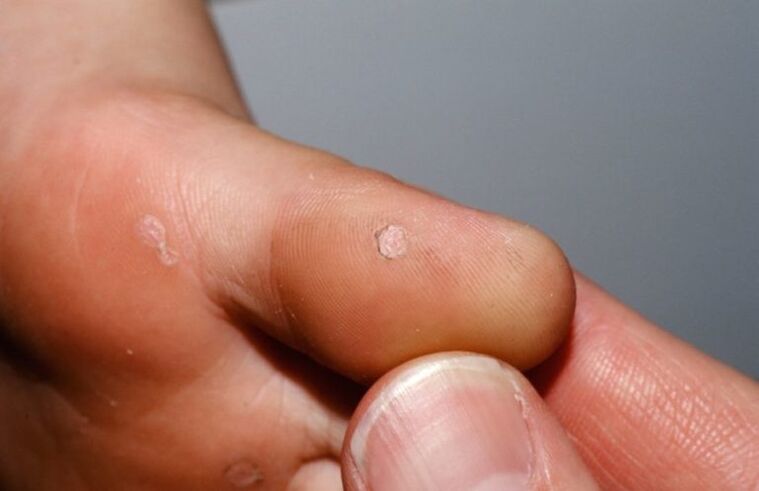
A strong immune system stops the virus from multiplying and puts it into a latent state. But as soon as the body's defenses are weakened, pathogens are activated and begin to multiply rapidly. Recently illness, stress, violation of standards of personal hygiene have become provoking factors that weaken the immune defense. The following factors contribute to the formation of warts:
- excessive sweating of the feet;
- wearing tight, uncomfortable shoes;
- micro-injury of the skin (scratches, abrasions, wounds, abrasions);
- frequent contact with water and detergents causes dryness of the skin;
- chronic diseases associated with impaired blood circulation in the lower extremities (diabetes, atherosclerosis, varicose veins);
- foot deformities (flat feet, arthritis of the small joints, osteoarthritis);
- constantly forming calluses, corns.
Plantar warts can be encountered when wearing an infected person's shoes or going to a pedicure salon where tools are poorly disinfected. Warts in children often form after going to a swimming pool, summer camp, or public shower, where a child may misplace someone else's shoes, walk barefoot on a dirty surface, or use someone else's personal belongings. carrying germs (towels, face towels, etc. ). Parents should teach their children to follow the rules of personal hygiene as soon as possible and explain why it is not possible to use other people's things.
What does a plant wart look like?
The incubation period, during which the papilloma virus multiplies, is quite long - from 1. 5 to 4 months. The pathogen first affects the basal layer of the epidermis, then spreads upward, leading to the formation of characteristic nodules on the skin.
Initially, warts on the feet of children or adults look like a glossy plaque that is round and small in diameter (up to 2 cm). Soon its surface becomes rough, covered with a dense horny layer, protruding above the surface of the skin. The color of the spines changes from fleshy to yellow-gray. A crater-shaped depression appears in the center of the tumor. On closer inspection, black dots can be seen on the surface of the wart. These are the thrombus-forming capillaries that go to the surface. The presence of this feature allows you to distinguish tree warts from calluses or calluses. A photo of vegetative warts provides a complete picture of this formation on the skin.
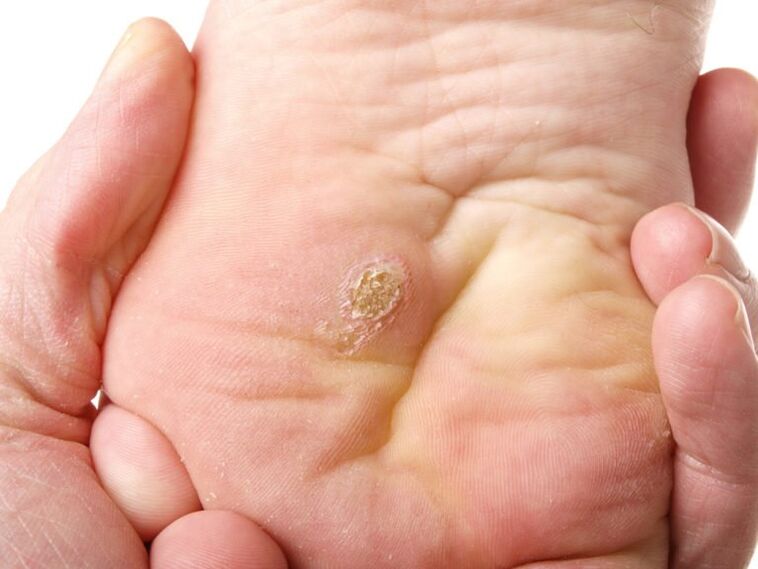
The preferred location for the spikes is the area of the foot that experiences the greatest pressure. The root of the tumor goes deep into the dermis, causing irritation of the nerve endings, so such warts cause pain when walking. Growths on the soles of the feet are single and multiple. Usually, a large maternal wart appears first on the foot. If the virus is very active, then soon little daughter formations will be formed next to it. Sometimes the spine disappears on its own, but more often the constant trauma leads to its growth and the appearance of severe pain due to the constant pressure of the shoe.
How to get rid of warts on the feet if such formations are painful and cause severe discomfort? First of all, you need to contact a dermatologist for examination and treatment. Plantar warts are not easy to deal with because they grow deep into the dermis. To prevent the spine from reappearing, the base of the tumor must be completely removed. This can be done in a variety of ways - medication and surgery.
Plantar warts: treatment
There are several methods of dealing with warts. At home, pharmacy products can be used to treat plantar warts. The doctor should choose a treatment regimen, since a positive effect can be achieved only with a correct and competent approach.
Drug treatment
To treat warts at home, many methods are used - from destruction with strong chemicals (acids, alkalis) to freezing of pathological tissues with special means. To rule out recurrence, it is necessary not only to eliminate the growth, but also to suppress the viral activity.
Complex treatment methods are based on the following groups of drugs:
- Antiviral and immunomodulatory agents.Creams that activate local immunity and inhibit viral replication have a good therapeutic effect. It must be applied twice a day under the bandage. For the same purpose, a cream that stimulates the production of interferon is used.
- Horny medicine.Preparations based on salicylic acid or trichloroacetic acid are designed to soften and remove the rough horny layer of warts. Removing dead scales allows you to reach the base of the wart and facilitates the penetration of solutions that cause infection or necrosis to its base. This is the only way to avoid the reappearance of new formations and remove the spikes permanently.
- Necrotic drugs.To combat warts, you should buy solutions based on acid or alkali with embalming effect at the pharmacy. Penetrating the structure of the tumor, the substances actively burn the infected tissue, as a result of which the wart becomes necrotic and dies. When using such drugs, care must be taken, or you may experience chemical burns to healthy skin. It is permissible to treat warts in children with necrotic agents only after consulting a dermatologist.
- Password declaration. . . The principle of action of these funds is based on freezing the tissues of the wart. Under the action of extremely low temperatures, the liquid inside the pathological cells freezes and breaks them from the inside. As a result, the wart will die within 7-10 days. The best products for freezing are produced in aerosol cans equipped with a special nozzle for application.
The procedure should be started after consulting a dermatologist. Only a specialist can accurately assess the situation and advise on how to remove warts at home. Self-medication often leads to short-term effects and repeated relapses, because the spread of the virus cannot be stopped.
Warts in children
Treatment of warts on children's feet is carried out using gentle methods. Children's skin is delicate and delicate, so strong products can cause irritation or burns. It is best to use drugs that have the effect of dehorning, softening and peeling of horny scales. This method of treatment is not quick - it will take 2-3 weeks to remove the wart.
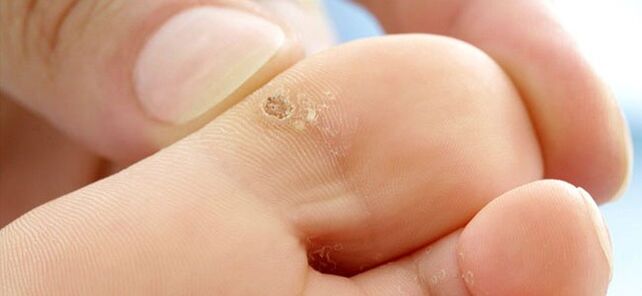
Keratolytics should be started at an early stage of cancer formation. In this case, the reappearance of the accumulation can be avoided. If the spine has grown deeply, you will have to resort to hardware treatments to bring about the desired results and ensure no recurrence.
If the wart does not cause much concern, you can treat it with folk remedies - a solution of acetic acid, lemon juice, garlic tincture. The acidic environment kills the virus, stops its reproduction, and prevents the growth of the virus.
Surgery
Classic operations with the use of a scalpel are rarely used. Such intervention is permissible only when removing large growths that cannot be removed by other methods. Surgery is performed under local anesthesia. The surgeon removes the wart and cleans the wound, trying to completely remove the deep root. The disadvantages of this method include pain, the risk of wound infection and subsequent development of complications, a long recovery time, in which a person has limited mobility.
It is better to remove the wart using a less traumatic and safe hardware technique. Referral to the procedure is given by the doctor after a preliminary examination and identification of contraindications. The main treatment options are:
Condenser
The essence of this method is to cool the tissue of the structure with a high-frequency electric current. The procedure is carried out with the use of local anesthesia, as it is accompanied by painful sensations. This option is suitable only for the removal of spines of medium size, with shallow germination into the depths of the dermis. If large warts are crusted, the risk of scarring and recurrence cannot be excluded.
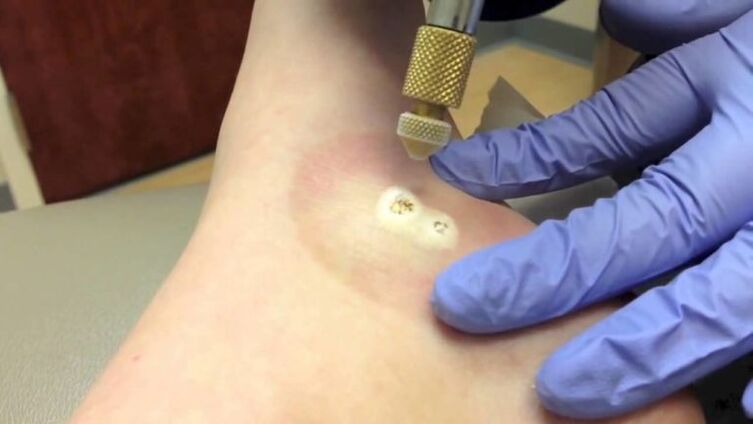
The recovery time after electrocautery is quite long, it is necessary to treat the wound with antiseptic solutions to eliminate infection. During the recovery process, the patient has limited mobility, due to the load on the leg causing painful sensations.
Cryodestruction
This is one of the most popular and affordable methods for treating warts. The procedure takes only a few minutes and involves treating the tumor with liquid nitrogen. Extremely low temperature provides instant freezing effect. The frozen liquid ruptures the pathological cancer cells from the inside - as a result the wart becomes necrotic and dies within 10 days.
During surgery, your doctor will press a cold instrument against the tumor for a few seconds, protecting it from surrounding healthy tissue. The effectiveness of the procedure is demonstrated by the lightening of the skin in the treatment area. Immediately after, a blister forms at the site of the wart, which should not be touched or poked. It is recommended to cover with a layer of plaster to avoid injury. After a few days, the blister will dry and a crust will form in its place. After the wart falls off, new, healthy skin remains at the wart site.

The procedure should only be performed by an experienced technician. Too long of exposure causes damage to deep tissues, leading to scar formation, and too superficial contact does not destroy the root of the wart, which leads to the appearance of new acne spots.
Laser removal
State-of-the-art procedures for the best cosmetic results, allowing you to control the depth of the incision, eliminating the risk of complications. Laser radiation vaporizes each layer of wart tissue, while coagulating blood vessels and disinfecting the surgical site. Such an effect eliminates the risk of bleeding, infection, ensures no recurrence, as it prevents the spread of viral particles. Different types of lasers are used to remove warts - wart, acid, or pulsed.
The laser procedure is safe, effective, painless and requires no long recovery time. At the site of the wart that has been removed, a small wound remains, which is covered with plaster. After the procedure, the patient can immediately go home and resume normal activities. The recovery time is very short - complete healing takes only a few days.
Remove with a radio knife
The essence of the latest technique is the use of radio waves, which allows you to remove warts in the fastest and safest way. Powerful thermal radiation burns away the build-up without direct contact with surrounding tissues. The fluid in the cells of the tumor immediately evaporates, causing the destruction of the wart. At the same time, the skin is not damaged, during the procedure, the doctor will adjust the depth and time of contact. At the same time, high-frequency radio waves disinfect the surgical area and heal the blood vessels, which eliminates the risk of bleeding.
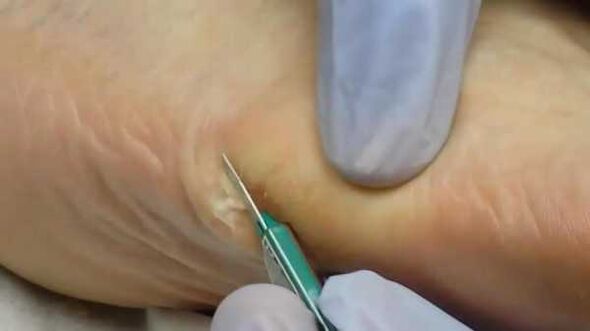
The method of dealing with warts to choose from, the patient decides to combine with the attending physician. Before appointing the procedure, the dermatologist finds out the cases of contraindications.
List of restrictions on the use of any hardware method:
- inflammatory processes on the skin in the treatment area;
- Diabetes;
- infectious diseases, respiratory tract (ARVI, ARI);
- hypertension;
- exacerbation of herpesvirus infection;
- pregnancy.
Questions about the use of device methods regarding the child are discussed with the physician. Some procedures have an age limit, so you should learn in advance all the nuances of the proposed methods and make sure that there is no harm to the health of the baby.

























